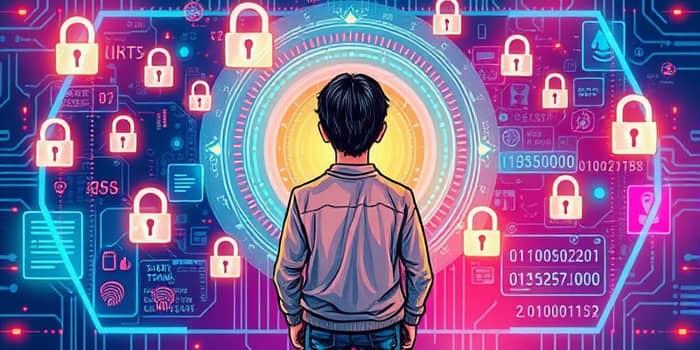In an era of interconnected devices and instant transactions, understanding and fortifying your electronic representation of self is more critical than ever. Digital identity underpins every click, purchase, and login.
This article explores how to define, manage, and protect your online persona across rapidly evolving threats and technologies.
Definition and Overview
At its core, digital identity is an electronic representation of an individual or entity used for authentication and access control. It combines data elements and behavioral patterns to establish trust in the digital realm.
From logging into social platforms to approving financial transactions, a robust digital identity framework ensures that only authorized actors gain access to sensitive resources.
Components of Digital Identity
Digital identity relies on multiple interconnected elements, each playing a distinct role in establishing and verifying who you are online.
- Identifiers: Usernames, email addresses, device IDs, IP addresses.
- Credentials: Passwords, PINs, one-time tokens, biometric scans.
- Personal Attributes: Inherent traits (fingerprints, eye color), assigned IDs (social security number), accumulated records (purchase history).
- Device and Usage Data: Hardware fingerprint, IMEI numbers, cookies, geolocation.
- Behavioral Data: Browsing patterns, transaction logs, social media interactions.
- Entitlements: Roles, permissions, access credentials for networks and applications.
Types of Digital Identity
Different forms of digital identity serve human and non-human actors, each with unique management requirements.
- Human Identity: Individual users such as customers, employees, and partners.
- Machine Identity: Devices, applications, and IoT components requiring automated authentication.
- Character Identity: Avatars and gaming profiles representing created personas.
- Reputation Identity: Scores, endorsements, employment and credit histories.
Lifecycle and Management
Effective digital identity management spans creation to decommission, ensuring security and compliance at every stage.
Identity federation and single sign-on simplify user experience, while administrative oversight and audit trails maintain accountability and transparency.
Security and Privacy Risks
The ascent of online services has made digital identity a prime target for cybercriminals. Identity theft and fraud remain rampant, with stolen credentials often sold on underground markets.
Data breaches expose millions of records annually, enabling phishing, social engineering, and large-scale surveillance. The concept of a “data double”—an aggregated digital footprint—raises profound privacy concerns, as companies and governments compile ever more detailed profiles.
Technologies for Securing Digital Identity
Advancements in authentication and trust frameworks help mitigate threats while streamlining user workflows.
Traditional passwords, though ubiquitous, are increasingly supplemented by multifactor authentication (MFA), combining something you know (password), something you have (token or mobile device), and something you are (biometric). Certificate-based authentication leverages public key infrastructure to validate devices and servers, while zero trust architectures insist on continuous verification at every access request.
Federated identity services and SSO reduce password fatigue by centralizing authentication across multiple platforms, enhancing both security and convenience.
Regulatory and Compliance Considerations
Global regulations like GDPR and CCPA dictate stringent requirements for collecting, storing, and processing identity data. Organizations must implement consent-driven data practices, minimize data retention, and provide transparent controls to users.
Failure to comply can result in significant fines, reputational damage, and erosion of customer trust.
Challenges and Trends
As digital identity becomes more valuable, threats intensify. In 2022, US consumers lost an estimated $43 billion to identity fraud, while over 80% of breaches in 2023 involved compromised credentials. Password reuse and weak authentication remain leading causes of exposure.
Emerging trends include decentralized, self-sovereign identity models built on blockchain, giving individuals greater control over their data. Biometric adoption is skyrocketing, with markets projected to exceed $70 billion by 2027. Organizations are increasingly moving toward passwordless solutions, relying on secure tokens or device-based cryptographic keys.
Best Practices to Protect Your Digital Identity
Adopting a comprehensive security mindset can drastically reduce risk and safeguard personal data.
- Use unique, complex passwords stored in a reputable password manager.
- Enable MFA on every account supporting two or more verification factors.
- Regularly update software and firmware to patch vulnerabilities.
- Remain vigilant against phishing—verify senders and avoid suspicious links.
- Employ privacy-focused browsers and adjust cookie settings on websites.
- Monitor account activity and credit reports for anomalies.
- Familiarize yourself with privacy settings on all digital services.
Education is key: stay informed about evolving threats and response strategies to maintain control over your digital identity.
The Future of Digital Identity
The digital identity landscape will continue evolving, driven by innovation in authentication, privacy-by-design principles, and expanding applications in government, healthcare, and finance.
As adoption deepens, individuals and organizations must remain vigilant, balancing convenience with security to preserve trust in the digital ecosystem. Proactive identity governance and emerging decentralized models promise to empower users while fortifying defenses against ever-more sophisticated threats.
References
- https://www.techtarget.com/whatis/definition/digital-identity
- https://www.tencentcloud.com/techpedia/127229
- https://en.wikipedia.org/wiki/Digital_identity
- https://www.sailpoint.com/identity-library/digital-identity
- https://www.adnovum.com/blog/digital-identity
- https://www.oracle.com/security/identity-management/digital-identity/
- https://pages.nist.gov/800-63-3/sp800-63-3.html
- https://www.1kosmos.com/identity-management/digital-identity-management-how-to-do-it-right/










